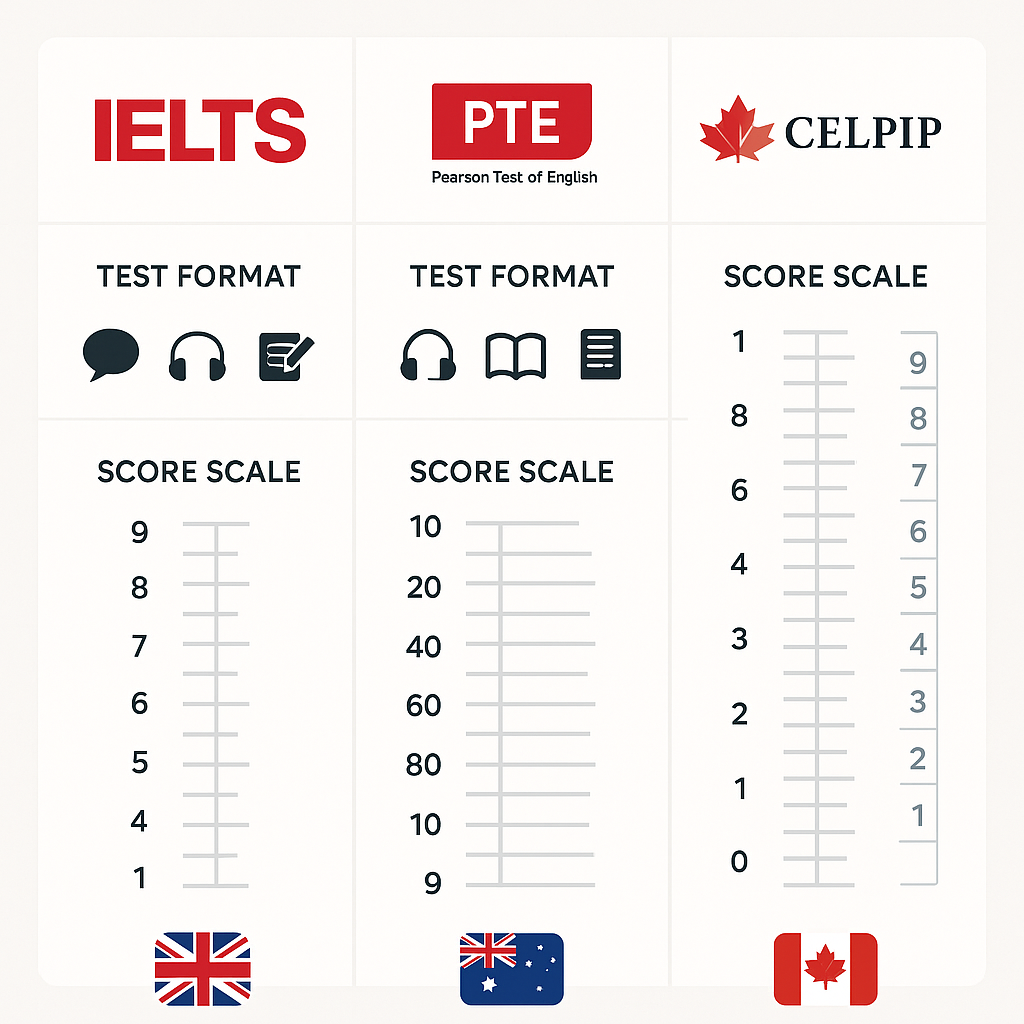IELTS vs PTE vs CELPIP: 2025 Score Comparison
In 2025, choosing the right English proficiency test can make or break your Canada PR application, university admission, or professional certification. With IELTS, PTE, and CELPIP all vying for your attention, a clear understanding of their scoring systems, formats, and strategic advantages is crucial. This comprehensive guide—“IELTS vs PTE vs CELPIP score comparison 2025”—will help you decide which test best aligns with your goals, study style, and timeline.
Hanish


1. Test Formats & Scoring Systems
All three exams assess Listening, Reading, Writing, and Speaking, but their formats and scoring scales differ dramatically:
All three exams assess Listening, Reading, Writing, and Speaking, but their formats and scoring scales differ dramatically:
Key takeaway: IELTS’s band system is familiar worldwide, but its slower turnaround may not suit tight immigration timelines. PTE’s rapid scoring and single-platform delivery have made it the “best PTE test for busy professionals,” while CELPIP’s Canada-focused design and CLB mapping give it an edge for PR seekers.
2. Speaking Section Analysis
IELTS Speaking (11–14 minutes) uses live examiners, allowing for natural interaction but risking examiner bias.
PTE Speaking (77–93 minutes total) integrates speaking tasks into a digital environment, scored by AI. Its template-driven approach helps many candidates hit target scores.
CELPIP Speaking (approx. 20 minutes) features everyday workplace dialogues and customer-service scenarios, mirroring real-life Canadian conversations.
Strategy : If you thrive on human interaction, IELTS can be advantageous. For consistent AI scoring and immediate feedback, PTE’s speaking platform is ideal—something many “best CELPIP coaching online India” students overlook. CELPIP’s Canadian accent practice makes it unbeatable for PR-focused candidates.
3. Listening & Reading Comparison
IELTS Listening (30 minutes) features four recordings with a variety of accents (British, Australian, North American).
PTE Listening (approx. 45–57 minutes) offers a mix of multiple-choice, fill-in-the-blank, and dictation, all AI-scored.
CELPIP Listening (47–55 minutes) uses exclusively Canadian accents, helping you train specifically for CLB mapping.
Tip: Use targeted accent drills for CELPIP and PTE algorithm updates practice tests for PTE. For IELTS, build comfort with diverse English dialects by rotating BBC, NPR, and Australian Broadcasting Corporation podcasts.
4. Writing Section Differences
IELTS Writing requires a graphical report (Task 1) and an essay (Task 2), scored by certified examiners.
PTE Writing combines essay and summarizing written text tasks into one seamless session, with AI evaluating grammar, structure, and content.
CELPIP Writing features an email scenario and essay, scored by a blend of AI and human raters to reflect real-world business and social contexts.
Hack : Practice PTE’s template responses to maximize AI scoring, while for IELTS, refine band-specific vocabulary and coherence markers. CELPIP candidates should focus on Canadian workplace and community examples.


5. Which Test Is Best For You?


Case Study: Ankit, a software engineer from Mumbai, needed CLB 8 for CRS points. He chose CELPIP for its Canada-specific content, achieved CLB 9 in his first attempt, and secured an IT job in Vancouver within three months.
Conclusion & Next Steps
Choosing between IELTS, PTE, and CELPIP in 2025 depends on your personal strengths, timelines, and Canada PR strategy. Whether you prefer AI-driven consistency (PTE), Canadian-focused contexts (CELPIP), or global recognition (IELTS), LinguoPrep’s expert trainers will ensure you hit your target score on the first attempt.
Ready to master your chosen test? Enrol in our
and transform your language goals into reality!


